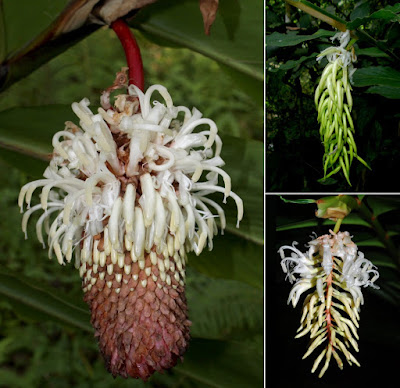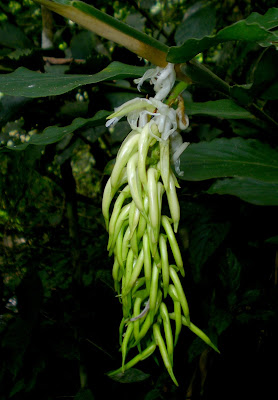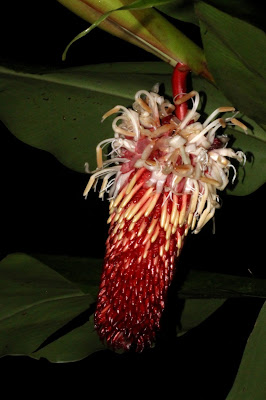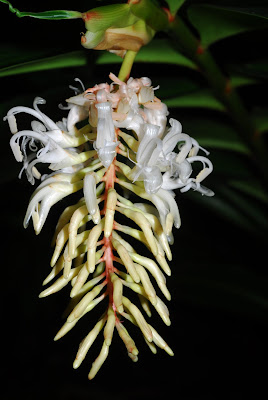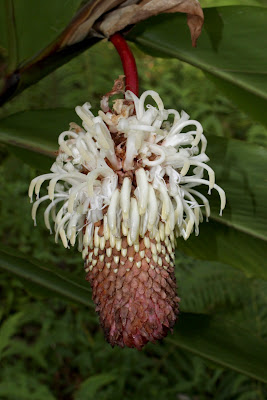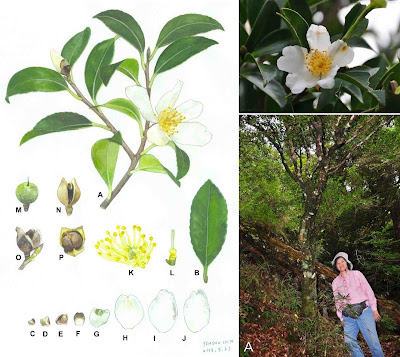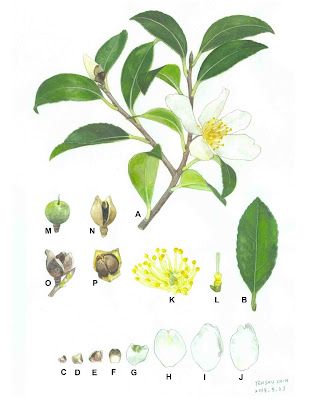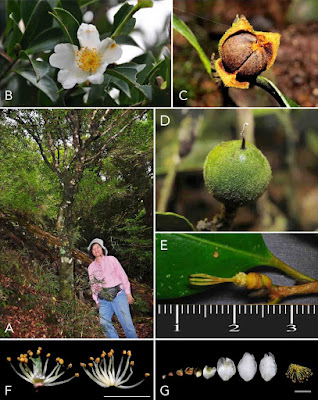[Most Recent Entries] [Calendar View]
Thursday, July 25th, 2019
| Time | Event | ||||||||||
| 6:22a | [Botany • 2019] Recircumscription and Revision of the Genus Vanoverberghia (Zingiberaceae)
The genus Vanoverberghia currently includes three species namely V. sepulchrei and V. rubrobracteata from the Philippines and V. sasakiana from Taiwan. New material targeting the Alpinia eubractea clade of the tribe Alpinieae was used to test the monophyly of Vanoverberghia. A combined analysis of the ITS and trnK/matK regions reveals that these three species form a strongly supported monophyletic clade with Alpinia diversifolia and Alpinia vanoverberghii. The morphological descriptions of all species were updated after examining recent collections and comparing with types and protologues. The original description of A. diversifolia did not include information on the flowers which are described here. The morphology of A. diversifolia and A. vanoverberghii is for most parts in accordance with the previous perception of the genus but a few characters are added and a recircumscription of Vanoverberghia is subsequently provided here. Vanoverberghia diversifolia is reinstated and A. vanoverberghii is combined in Vanoverberghia. Furthermore, collections from northern Luzon documents the presence of V. sasakiana and all species of Vanoverberghia thus occur in the Philippines. A key to the five species is provided including a comprehensive taxonomic revision and designation of three lectotypes. Keywords: Alpinia; ITS; Lanyu; Luzon; new species record; trnK/matK
R.V.A. Docot, C.I. Banag, D.N. Tandang, H. Funakoshi and A.D. Poulsen. 2019. Recircumscription and Revision of the Genus Vanoverberghia (Zingiberaceae). Blumea. 64; 140–157. DOI: 10.3767/blumea.2019.64.02.05 J.H.B. Ambida, A.M.A. Alviar, P.S.A. Co, F.G.M. Concepcion, C.I. Banag and R.V.A. Docot. 2018. A New Species of Vanoverberghia (Zingiberaceae) from the Philippines. Blumea - Biodiversity, Evolution and Biogeography of Plant. DOI: 10.3767/blumea.2018.63.02.07 | ||||||||||
| 8:33a | [Botany • 2019] Camellia chinmeii (Theaceae) • A New Species of Camellia sect. Paracamellia in Taiwan
Abstract A new species of Camellia chinmeii S.L. Lee & T.Y.A. Yang (Theaceae; sect. Paracamellia Sealy) is described. Camellia chinmeii has sessile flowers, six to ten perules, four or five white, early deciduous petals, yellow radiating stamens separate to the base or nearly so, style 6-7 mm long and fused 1/2 to 2/3 from the base, densely tomentose ovary. The fruit is a globose, beaked or unbeaked capsule. Keyword: Camellia chinmeii, New species, Section Paracamellia, Theaceae, Taiwan Camellia chinmeii S.L. Lee & T.Y.A, Yang, sp. nov. Diagnosis: Similar to Camelia brevistyla, but differing in having fewer stamens, fewer filaments free from each other, longer styles and smaller fruit. It is also similar to Camellia confusa, but has smaller leaves and flowers, fewer stamens and smaller fruit. It is also similar to Camellia hengchuensis, but has thin leaves and globose fruit. It is also similar to Camellia kissi, but differs in having the filaments free from each, longer styles and globose fruit. Distribution and ecology: Endemic to Taiwan. Camellia chinmeii mainly occurs in mountainous areas between 2000 and 2350 m on gentle slopes in forests on Mt. Weishangshan, Nantou County, in central Taiwan. Etymology: The specific epithet, chinmeii, honors Ms. Chin-Mei Hung, wife of the first author, who first recognized Camellia chinmeii as a new taxon in 2010; she passed away during a field trip on 6 December 2014. Shih-Lin Lee and Tsung Yu Aleck Yang. 2019. Camellia chinmeii, A New Species of Camellia sect. Paracamellia in Taiwan. Taiwania. 64(3); 321-325. DOI: 10.6165/tai.2019.64.321 | ||||||||||
| 10:44a | [Herpetology • 2019] Dipsadoboa montisilva • A New Species of Tree Snake (Dipsadoboa, Serpentes: Colubridae) from ‘Sky Island’ Forests in northern Mozambique, with Notes on other Members of the Dipsadoboa werneri group
Abstract A new species of tree snake Dipsadoboa montisilva Branch, Conradie & Tolley sp. nov. (Serpentes: Colubridae) is described from the ‘sky islands’ of Mount Mabu and Mount Ribáuè in northern Mozambique. Features of scalation, colour, body form and habitat distinguish the new species from other Dipsadoboa. This is supported by a phylogenetic analysis using one mitochondrial marker (cytochrome b) that shows the new Mozambican species is divergent from other sampled Dipsadoboa, including D. flavida and D. aulica, the only congeners known to occur in Mozambique. Morphologically, the new Dipsadoboa forms part of the D. werneri-shrevei complex from east and southeast Africa, but differs in having higher subcaudal counts, a different temporal pattern and only two supralabials entering the orbit. Phylogenetically, it occurs in a clade with D. shrevei and D. werneri. The status of D. shrevei in East Africa is reassessed, particularly in terms of the poorly-known Dipsadoboa shrevei kageleri from northern Tanzania. It is morphologically well defined from D. shrevei shrevei and utilises a different habitat. Although based on limited genetic data, it appears to be well-defined from typical D. shrevei and is accordingly raised to specific status. The only Tanzanian record for typical D. shrevei from Mtene, Rondo Plateau in southeast Tanzania is well isolated from the species’ range to the west (e.g. Zambia, Angola) and the published scalation features, particularly ventral counts, do not fully accord with D. shrevei. The Rondo Plateau population is treated as Dipsadoboa incerta sedis, and because we return D. shrevei to its binomial status, we can no longer consider D. shrevei as occurring in Tanzania. Biogeographically, the Rondo Plateau population may have a stronger affinity to the new Mozambican species. The discovery of isolated populations of the new species in mid-altitude forest remnants on Mt Mabu and Mt Ribáuè emphasizes the high conservation importance of the Mozambique forest ‘sky islands’ from which numerous other endemic new species have been recently discovered. These species are impacted by ongoing habitat destruction through slash and burn clearing for subsistence agriculture. Keywords: Reptilia, Dipsadoboa, Serpentes, Colubridae William R. Branch, Julian Bayliss, Gabriela B. Bittencourt-Silva, Werner Conradie, Hanlie M. Engelbrecht, Simon P. Loader, Michele Menegon, Cristóvão Nanvonamuquitxo and Krystal A. Tolley. 2019. A New Species of Tree Snake (Dipsadoboa, Serpentes: Colubridae) from ‘Sky Island’ Forests in northern Mozambique, with Notes on other Members of the Dipsadoboa werneri group. Zootaxa. 4646(3); 541–563. DOI: 10.11646/zootaxa.4646.3.6 Werner Conradie, Gabriela Bittencourt-Silva, Hanlie M. Engelbrecht, Simon P. Loader, Michele Menegon, Cristóvão Nanvonamuquitxo , Michael Scott and Krystal A. Tolley. 2016. Exploration into the hidden world of Mozambique’s sky island forests: new discoveries of reptiles and amphibians. Zoosystematics and Evolution. 92(2): 163-180. DOI: 10.3897/zse.92.9948 |
| << Previous Day |
2019/07/25 [Calendar] |
Next Day >> |
